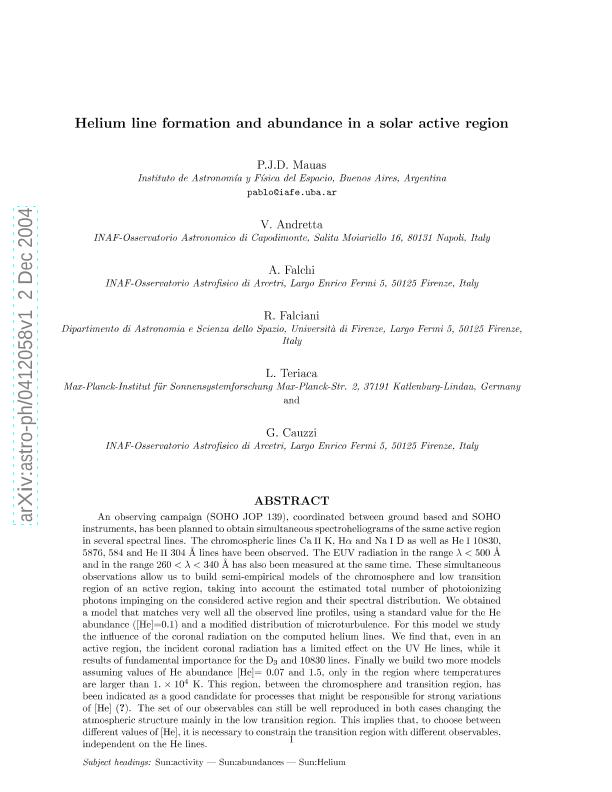Artículo
Helium Line Formation and Abundance in a Solar Active Region
Fecha de publicación:
12/2005
Editorial:
IOP Publishing
Revista:
Astrophysical Journal
ISSN:
0004-637X
Idioma:
Inglés
Tipo de recurso:
Artículo publicado
Clasificación temática:
Resumen
An observing campaign (SOHO JOP 139), coordinated between ground-based and Solar and Heliospheric Observatory (SOHO) instruments, has been planned to obtain simultaneous spectroheliograms of the same active region in several spectral lines. The chromospheric lines Ca ii K, H , and Na i D, as well as He i 10830, 5876, 584, and He ii 304 8 lines have been observed. The EUV radiation in the range k < 500 8 and in the range 260 < k < 340 8 has also been measured at the same time. These simultaneous observations allow us to build semiempirical models of the chromosphere and low transition region of an active region, taking into account the estimated total number of photoionizing photons impinging on the target active region and their spectral distribution. We obtained a model that matches very well all the observed line profiles, using a standard value for the He
abundance (½He ¼ 0:1) and a modified distribution of microturbulence. For this model we study the influence of the coronal radiation on the computed helium lines. We find that, even in an active region, the incident coronal radiation has a limited effect on the UV He lines, while it is of fundamental importance for the D3 and 10830 8 lines. Finally, we build two more models, assuming values of He abundance ½He ¼ 0:07 and 1.5, only in the region where temperatures are >1 ; 104 K. This region, between the chromosphere and transition region, has been indicated as a good candidate for processes that might be responsible for strong variations of [He]. The set of our observables can still be well reproduced in both cases, changing the atmospheric structure mainly in the low transition region. This
implies that, to choose between different values of [He], it is necessary to constrain the transition region with different observables, independent of the He lines.
Palabras clave:
Astrophysics
Archivos asociados
Licencia
Identificadores
Colecciones
Articulos(IAFE)
Articulos de INST.DE ASTRONOMIA Y FISICA DEL ESPACIO(I)
Articulos de INST.DE ASTRONOMIA Y FISICA DEL ESPACIO(I)
Citación
Mauas, Pablo Jacobo David; Andretta, V.; Falchi, A.; Falciani, R.; Teriaca, L.; et al.; Helium Line Formation and Abundance in a Solar Active Region; IOP Publishing; Astrophysical Journal; 619; 1; 12-2005; 604-612
Compartir




